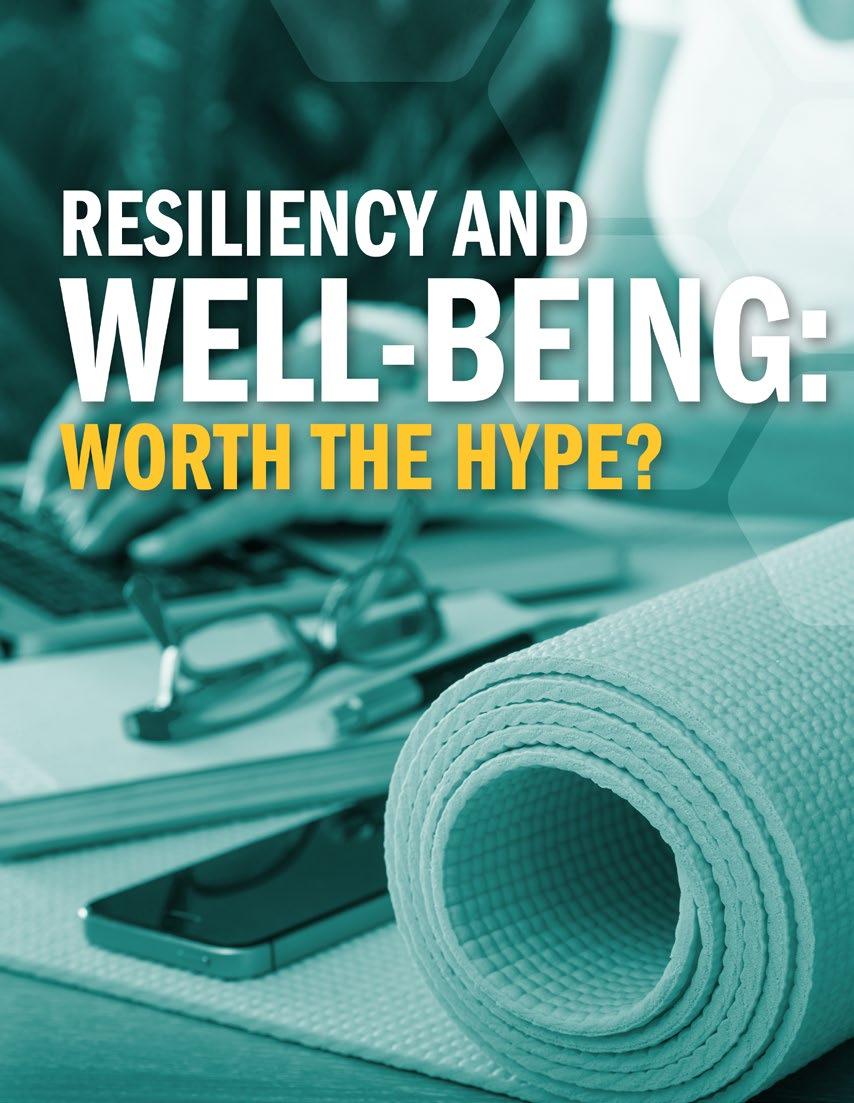
PART TWO OF A MULTI-PART PERKINS EASTMAN SERIES ON THE FUTURE OF WORK
New and accelerated shifts due to the pandemic have affected every aspect of life including how and where we work. These shifts include the untethering of work, wellness-centric migration, integration of technology, and higher demands for flexibility and equity. A comprehensive understanding along with how work will be performed is yet to be fully understood as they continue to evolve. Perkins Eastman’s Workplace leaders in collaboration with Design Research, and contributions from experts in complementary practice areas, explored the roots of these shifts and imagined possible future scenarios in a multi-part series.
In our second installment, Resiliency and Well-being: Worth the Hype? we explore resiliency and well-being, their importance, and ways of potentially supporting wellness through peoplefocused designs and policies.

OAK HEALTH CLUB 2 Resiliency and Well-being Perkins Eastman Design Research
KEY TAKEAWAYS

1. All talent are requiring healthier lifestyles and looking for employers that actively support their well-being.
2. Companies are at an increased risk of losing talent and revenue if they overlook employee well-being.
3. In adopting a holistic mindset, resiliency training, increasing engagement, and acquiring a deep understanding of their talents’ needs and barriers, companies can explore and apply relevant workplace designs and policies that best support resiliency and well-being.
3 Perkins Eastman Design Research
AN EMPLOYEE PRIORITY
Colliding Crises. The COVID-19 pandemic collided with pre-existing environmental, health, and societal crises such as global warming, the loneliness epidemic, and concerning behavioral health conditions (i.e., depression, anxiety, and substance abuse). In fact, 61% of Americans surveyed in 2019 were classified as lonely (up from 54% in 2018),1 and in mid-February to mid-March 2020 prescriptions for anti-anxiety medication increased by 34.1%.2
Nonetheless, in many cases, the sudden halt the pandemic brought to daily routines created precious opportunities for time with family, children, and hobbies, which may have contributed to internal reflections and prompted active changes to priorities.
The Great Migration… Again! Similar to other historic migrations in the U.S. such as the Dust Bowl in the 1930s and post-World War II relocations in the 1940s, most moves during the COVID-19 pandemic were economically motivated.3 Contrarily, a segment of the workforce population migrated during the pandemic to pursue a better quality of life and increased well-being. Such moves led to a boom in purchasing properties in small, suburban towns to capitalize on larger homes
for less, and greater access to nature.4 5 While many moved out of cities, it is speculated that younger talent will continue to move into cities seeking valuable social, professional, and personal connections.
These migration patterns along with unprecedented resignation rates,6 possibly portray a shift in workforce priorities and a focus towards seeking holistic well-being, engagement, and happiness in all aspects of life, including work. The perspective on work has perhaps shifted to one that acknowledges it is an invaluable part of life but not one that should be all consuming.
Focusing on well-being in the workplace is crucial since workplace stressors, (e.g., demanding tasks, economic insecurity, long hours, and work-family conflict), can be as harmful to health and well-being as secondhand smoke.7 Additionally, with people spending approximately a third of their lives working (about 90,000 hours),8 ensuring they are spending this time in a healthy, engaged, and happy state is crucial. After prolonged years of accepting a status quo that may not have placed well-being at the forefront of companies’ decisions and offerings, leaders and talent alike, are now actively seeking change.
3 out of 4 employees expect companies to support their health, well-being, and nutrition. 9

4 Resiliency and Well-being Perkins Eastman Design Research
72%
57%
Working at a company that ensures physical + mental health
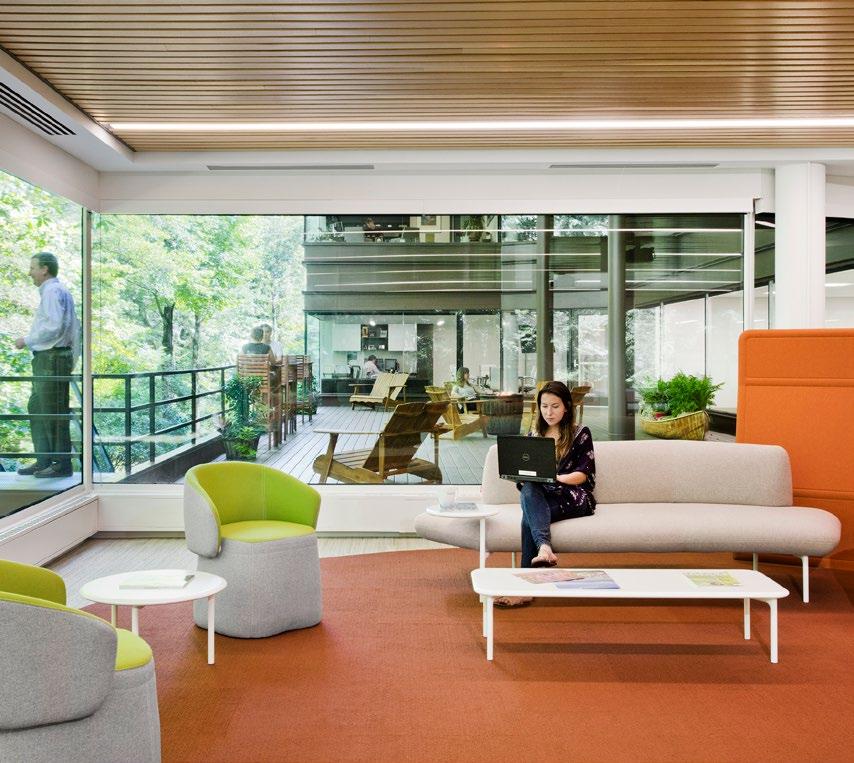
After prolonged years of accepting a status quo … leaders and talent alike, are now actively seeking change.”
Work-Life Balance
Priorities Post-Pandemic 9
Employee
TAUCK, INC. HEADQUARTERS 5 Perkins Eastman Design Research
A WAKE-UP CALL FOR BUSINESS
The mass exudes and current slow return to jobs despite suspension of many unemployment benefits,10 could serve as a clear indication to businesses that prioritizing employees’ well-being is not only altruistic, but economically essential. Although it may be tempting to think of the current workers’ and talent wellness demands as a blip businesses can overcome, studies predating the 2019 pandemic clearly demonstrate that ignoring well-being can cost billions of
Mental Health: Cost and Saving
$3.27
17%
Source: Gallup13
dollars in direct and indirect expenses such as diminished productivity and increased turnover.11 Additionally, well-being can impact engagement,12 an ingredient that can contribute to improved retention, sales, and profit.13 Therefore, leaders seizing the moment and investing in the well-being of their talent are simultaneously making strides towards improvements in company performance and revenue.
20%
Highly-engaged business units can achieve:
41% reduction in absenteeism
reduction in medical costs for every dollar spent on company wellness programs 14
estimated cost of absenteeism and presenteeism caused by major depressive disorders 15
$105B
59% less turnover
increase
in productivity
increase
sales
in
profitability
21% greater
6 Resiliency and Well-being Perkins Eastman Design Research

If you think that good design is expensive, you should look at the cost of bad design.”
—Sir Ralf Speth
ELAINE CONSTRUCTION 7 Perkins Eastman Design Research
AN OPPORTUNE MOMENT
With many company leaders and employees aligned in their pursuit of wellness centric workplaces for a variety of reasons, what can individuals and organizations do to better support workplace well-being?
We believe well-being requires:
• A holistic mindset.
• Resiliency training.
• Engaging and involving people.
• Building resiliency and well-being into policies and places.
Think Holistically.
Although companies hire individual talent, it is important to recognize employees are part of a complex ecological system. On an individual level, leaders should strive to support employees holistically, targeting as many dimensions of their well-being as possible (see figure on page 10 for dimensions of wellness),16 because supporting one dimension alone might not yield the best outcomes.17 The importance of each of these dimensions vary from person to person based on their phase in life, lifestyle, abilities, and so on.
As part of supporting these dimensions, it is crucial firms also nurture and enable employees’ connections with their families, company culture, social community, and the larger natural environment. Additionally, firms should not forget that physiological health is similarly critical to well-being and that the quality of the built environment, can have a profound impact. For example, improving indoor environmental quality (IEQ) through a variety of design decisions, such as avoiding materials that emit known toxins, is one way to address employee health and well-being.
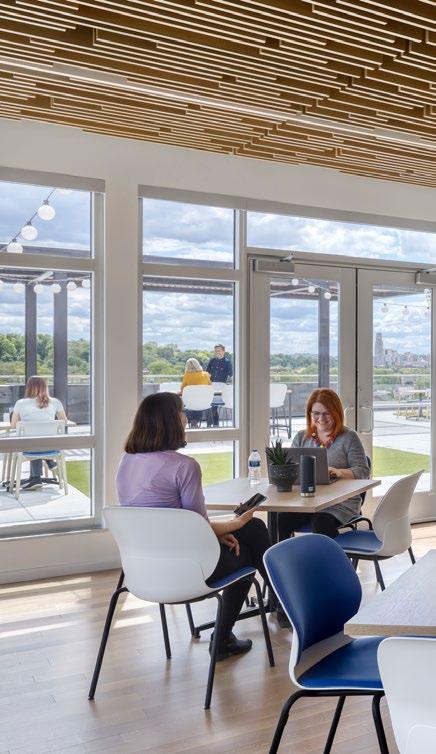
8 Resiliency and Well-being Perkins Eastman Design Research
90,000 hours
Time average person spends at work. 8
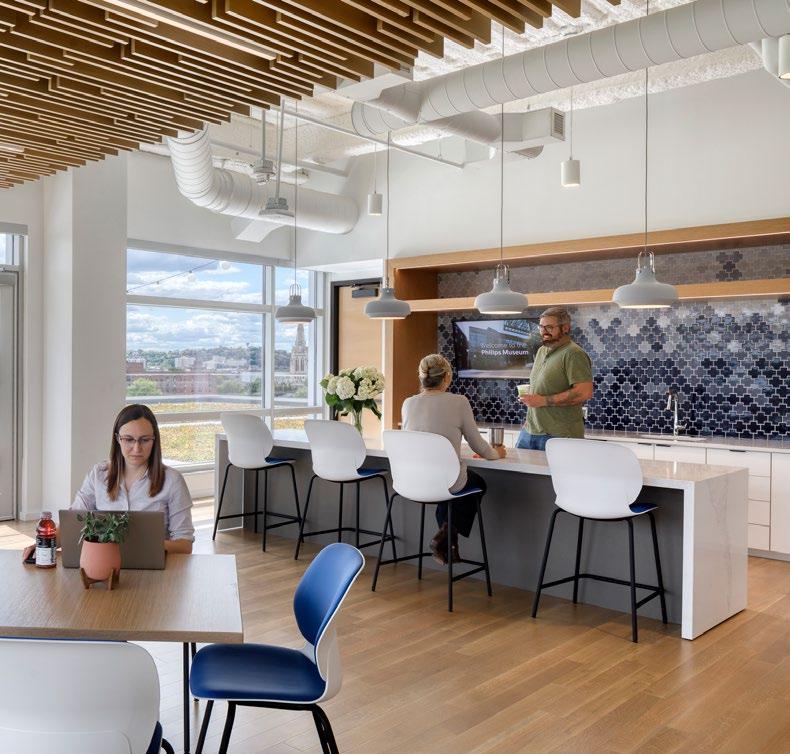
9 Perkins Eastman Design Research
PHILIPS
CENTER OF EXCELLENCE
Dimensions of Well-Being
Emotional Coping effectively with life and creating satisfying relationships
Financial Satisfaction with current and future financial situations
Social Developing a sense of connection, belonging, and a well-developed support system
Spiritual Expanding our sense of purpose and meaning in life
Occupational Personal satisfaction and enrichment derived from one’s work
Physical Recognizing the need for physical activity, diet, sleep, and nutrition
Intellectual Recognizing creative abilities and finding ways to expand knowledge and skills
Environmental Good health by occupying pleasant, stimulating environments that support well-being
Adapted from Workplace Wellness Lab16
Itnle l e c tua l S o c i a l Financial
Emotional Environmental
Dimensions of WELL-BEING Occupational Spiritual Physical
10 Resiliency and Well-being Perkins Eastman Design Research
Employees are part of an interdependent ecological system

emotional intellectual social emotional financial social occupational



SPATIAL SUPPORT
areas of refuge spatial layout for serendipitous interaction and learning day care (e.g., on-site or stipend)
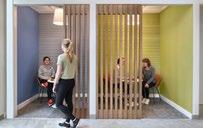

emotional environmental intellectual spiritual
individual family community environment
hosting community events/mentoring leasing office space to local start-ups access to nature (e.g., views, indoor plants) healthy, non-toxic materials


Compared to those thriving in multiple levels of wellness, those thriving only physically are: 17
68% missed days of work
5X more likely to seek new employment
3X more likely to file a compensation claim
2X more likely to change employers
OAK HEALTH CLUB
LAMB
ASCENDER
11 Perkins Eastman Design Research
TAUCK, INC.
Resiliency: the act of adapting, coping, and growing from difficult situations.
Layer on Resiliency.
In addition to focusing on holistic well-being, it is important to layer on resiliency training, that can enable individuals to face inevitable adversity and negative emotions they will face in life. Everyone will experience a level of adversities, be it an illness, loss, or even a global pandemic, the key however, is to be able to bounce back, which is what resiliency focuses on-the act of adapting, coping, and growing from difficult situations.18
The concepts of well-being and resiliency are complex and closely related. Yet while well-being captures one’s psychological state at a certain moment in time, resiliency is more dynamic and
considers past, present, and future factors.19 Layering resiliency onto our understanding of well-being can add an aspect of future-proofing and coping.
Resiliency often includes educational and training components from various fields such as positive psychology, relationship systems, and emotional intelligence. Resiliency training however can require both individual and organizational commitment.20 Although often discussed in relation to reducing burnout among healthcare workers, resiliency can have universal applicability in equal or less stressful workplaces.
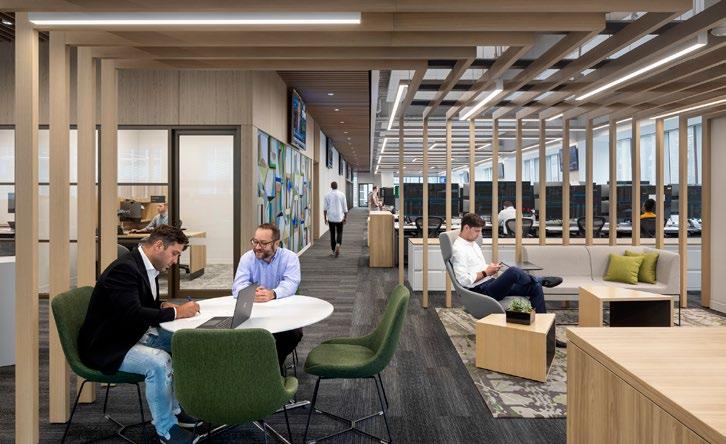
12 Resiliency and Well-being Perkins Eastman Design Research
TD SECURITIES
Recommendations for individuals and leaders seeking to support resiliency and well-being 22
Look inwards — Understand and discuss personal stressors with trusted professionals, seek meaningful work, practice selfcare, and seek various trainings (e.g., resiliency training, conflict management, positive psychology).
Build bridges — strengthen familial, social, and work relationships, particularly in an increasingly digital world.
Pay kindness forward — regularly performing unsolicited acts of kindness over a period of time can boost a person’s well-being.21 Additionally, through social contagion phenomena, such positive emotions can spread to others.
• Care, genuinely , about employees’ well-being, whether motivated altruistically or economically
• Commit to enhancing well-being
• Engage employees to identify challenges, and set well-being goals
• Normalize a culture of vocalizing and seeking help
• Model resiliency and wellness behavior through sharing personal efforts
• Train and equip leaders (particularly employees’ first line of contact)
• Establish and communicate resources available to all employees at all levels
• Extend support beyond an employee (especially caregivers) to include members of their household
• Measure and be accountable for the successes of plans that are created to achieve wellness and resiliency
13 Perkins Eastman Design Research
INDIVIDUALS LEADERSHIP
An open, safe, periodic, iterative, and data-supported process can help leaders and employees uncover well-being needs and barriers.
Engage and Involve People.
Employee engagement is often defined as the behavioral, cognitive, and emotional energy employees invest in their work and organization.23 Engaged employees care deeply about their work and go above and beyond.24 25 In addition to positively impacting retention, sales, and profit,13 as discussed above, engaged talent can demonstrate higher psychological well-being compared to those with low engagement.23 Well-being and engagement are also reciprocal with well-being influencing engagement and vice versa.26
Considering their many benefits, leaders should aim to foster both engagement and well-being which can be accomplished through many means, including; involving talent in conversations.
26 An
open, safe, periodic, iterative, and data-supported process can help leaders and employees uncover well-being needs and barriers. Needs and barriers will vary from individual to individual and depend on many aspects (e.g., familial situations, individual preferences, life stage, etc.), consequently, approaches to enhancing well-being need to be tailored to each unique workforce.
In addition to potentially contributing to engagement and well-being, involving talent in such a process is crucial because employees are familiar with their own circumstances and needs, and because asking for their input can bolster their satisfaction and engagement.20 Based on an understanding of their workforce (i.e., people), leaders can then examine potential workplace designs and policies that strive to support their firm’s particular well-being needs.
Examples of barriers to well-being across the workplace landscape
BARRIER
Commute
Distraction
Work-life separation
Choice, and decision fatigue
Fear of missing out (FOMO)
Isolation and loneliness
• Long-distance commutes can cause physical illnesses, negatively impact personal and social well-being,27 and by some estimates may require a 40% increase in pay to offset the discontent.28
• Losing a commute entirely can also decrease well-being.29
• Office distractions can include noise from colleagues,30 while home distractions stem from competing life / family demands.31
• Digital distractions can include constant on-screen notifications (emails, chat platforms, etc.).
• Depending on one’s home / family composition, a lack of separation can be fatiguing, lead to longer working hours, and/or isolation.31
• Too many choices, or irrelevant choices can result in decision fatigue32 while a lack of choice, especially on where to work, can result in increased turnover.33
• Working remotely can present a risk of FOMO.34
• Loneliness, in or out of the office, can impact individuals physical, mental health and cognitive functioning35 along with their work performance.36
14 Resiliency and Well-being Perkins Eastman Design Research

QLIC 15 Perkins Eastman Design Research
Build Policy and Place.
Findings from Perkins Eastman’s wellness studies across building types (e.g., senior living37 and K1238), demonstrate the built environment can positively contribute to people’s well-being and perceptions. Insights from these studies along with thoughts from the hospitality sector and workplace leaders were examined, adapted, and augmented for future testing and expansion. Drawing on this broader body of knowledge the workplace well-being design guidelines were built on a foundation that embraces the evolution of an individual from their first day on a job to their last, and all of life’s moments in between. Along with human-centered benefits and policies,
these guidelines can potentially help overcome some of the barriers to well-being across the workplace landscape as demonstrated below.
Work environment policies and spaces can contribute to well-being when applied thoughtfully and iteratively. Conversely, inflexible work environments that cannot adapt or respond to people’s evolving needs, be it over the course of the day or their careers, can hinder well-being and exasperate burnout. To help with workplace agility, policies and spatial designs need to be tested, refined, and continuously improved throughout a company’s lifespan based on the evolving needs of employees and the business.

16 Resiliency and Well-being Perkins Eastman Design Research
180 MAIDEN LANE
WELL-BEING DESIGN GUIDELINES
Support control, choice, and routine by providing options, and flexibility over when, where, and how to work.
Tailor a variety of spaces and experiences to support the range of needs and workstyles most relevant to the employee composition.
Nudge people towards healthy choices (e.g., sit-to-stand desks, destinations for nourishment, reflection, activity, etc.)
Vary patterns of movement to include direct and winding routes for discreet physical activity, social connections, and moments of calm.
Foster serendipitous opportunities and chance encounters to help promote innovation and develop / sustain meaningful connections among employees.
Offer degrees of privacy, both acoustical and visual, to balance dichotomous needs: focus (cognitive need) and connections (social/work need).
Connect to nature and daylight to capitalize on their abundant benefits through incorporating Biophilic design patterns.
Design sensory experiences by varying textures, scales, colors, natural elements, and pleasant fragrances (lavender for calm 39 and cinnamon for enhanced cognition). 40
Encourage moments of calm for emotional and cognitive rejuvenation through areas of refuge, and special software.
Foster pro-environmental and pro-social behaviors via purposeful design interventions.
17 Perkins Eastman Design Research
WORKPLACE LANDSCAPE
Examples of design guidelines, policies, benefits and resources that can help mitigate potential barriers to well-being across the workplace landscape. The examples here are not meant to be exhaustive; rather they are a starting point for companies and their employees to consider in collaboration with their workplace strategists and designers.
HEADQUARTERS HOME
AUGMENTED PLACES i
OFFERINGS
• A home Base
• Host clients and visitors
• Collaboration and innovation
• Team meetings/work
• Social/collegial connections
• Connection to company culture
POTENTIAL WELL-BEING BARRIERS*
• Long commute
• Distraction
• Choice and decision fatigue
• Loneliness
WELL-BEING DESIGN GUIDELINES
• Utilize the Well-Being Design Guidelines (e.g.)
• Control, choice, routine
• Tailored variety
• Behavioral nudges
• Serendipity
• Degrees of privacy
POLICY + ADVANTAGES
• Assuming people spend less time at an office:
• Invest in a well-rounded concierge service for an efficient and stress-free experience and resource
• Invest in technology/apps / interfaces that connect distributed groups equitably
OFFERINGS
• Focused, heads-down work
• Work/life separation
• Social/collegial connections
• Connection to company culture
• Collaboration and innovation
POTENTIAL WELL-BEING BARRIERS*
• Distraction
• Choice and decision fatigue
• Loneliness
WELL-BEING DESIGN GUIDELINES
• Utilize the Well-Being Design Guidelines (e.g.)
• Control, choice, routine
• Tailored variety
• Behavioral nudges
• Serendipity
• Degrees of privacy
POLICY + ADVANTAGES
• Devise rotation schedules for managers for equitable interaction with employees
• Invest in technology that connect distributed groups equitably
OFFERINGS
• Focused, heads-down work
• Managing work/life demands
POTENTIAL WELL-BEING BARRIERS*
• Lack of commute
• Distraction
• Lack of work/life separation
• Fear of Missing Out
• Loneliness and isolation
WELL-BEING DESIGN GUIDELINES
• Provide home-office fund for furniture, technology, etc.
• Employees can consider applying the design guidelines to their home as applicable, (e.g.):
• Degrees of privacy
• Nature and daylight
POLICY + ADVANTAGES
• Safe-guard work/life separation: institute communication-free hours
• Invest in technology that connect distributed groups equitably
18 Resiliency and Well-being Perkins Eastman Design Research
DIGITAL SPACES
4TH PLACES
POLICIES + ADVANTAGES
OFFERINGS
• Collaboration and innovation
• Team/client meetings
• Social/collegial connections
POTENTIAL WELL-BEING BARRIERS*
OFFERINGS
• Focused, heads-down work
• Collaboration and innovation
• Team/client meeting
• Social/collegial connections
POTENTIAL WELL-BEING BARRIERS*
• Distraction
• Fear of Missing Out
• Loneliness and isolation
WELL-BEING DESIGN GUIDELINES
• Having experienced workplaces designed to support well-being, untethered talent may seek non-conventional workplaces (café, hotel lobbies) that embody them as well.
POLICY + ADVANTAGES
• Provide easy and secure access to company networks and resources from anywhere
• Invest in technology that connect distributed groups equitably
• Lack of commute
• Distraction
• Lack of work/life separation
• Fear of Missing Out
• Loneliness and isolation
WELL-BEING DESIGN GUIDELINES
• Workplace designers and software engineers to collaborate on creating healthy virtual spaces
POLICY + ADVANTAGES
• Invest in optional software that limits distractions (pop-ups/notifications), and nudges towards desired behaviors (e.g.) break reminders, do-not-disturb functions, meditation moments, gaze breaks, etc.
OVERARCHING WORK LANDSCAPE POLICIES + ADVANTAGES
• Provide optional and continued wellbeing and resiliency training
• Provide a variety of resources and behavioral health coverage plans that align with workforce needs
• Scrutinize fads, instead research, test, and adapt successful existing policies (e.g.):
• Shorter more productive work-weeks
• Parental leave
• Flexible hours
• “Vab” the Swedish term for taking the day off to care for a sick child. Expand to include anyone in an employee household who is in need.
• Paid vacation
• Stress leave
* To explore the Workplace Landscape further, refer to our previous publication: Work from Anywhere?39 DOWNLOAD
i As
ii
Places
i
i
in
described in the first installment of this series: Work from Anywhere, Augmented Places can include smaller dispersed offices
major cities or suburban residential pockets.
like; local cafés, hotels, etc. 19 Perkins Eastman Design Research
Fourth
include a network of spaces located in convenient, accessible, and distributed locations,
FROM HYPE TO SILVER LINING
The COVID-19 pandemic’s multifaceted impact on people is undeniable and has led to many changes and reactions, including employees choosing to migrate towards wellness-centric life styles be it out of desire or necessity. Whether fully relocating to new geographic homes, changing careers, seeking change from current employers, or leaving the workforce entirely, employees’ priorities have shifted towards personal care and wellbeing. Employers will therefore need to be deliberate and take actions to support these shifts. By the same token, employees should reciprocate and continue to put leadership’s minds’ at ease through demonstrating enhanced commitment and productivity. If we can capitalize on this disruption and use it as a meaningful pivot towards healthy workplaces, and expanded access to global talent, then this can be an opportunity as well as a silver lining that emerges.
“We delight in the beauty of the butterfly, but rarely admit the changes it has gone through to achieve that beauty.”
— Maya Angelou

SMITH+NEPHEW 20 Resiliency and Well-being Perkins Eastman Design Research
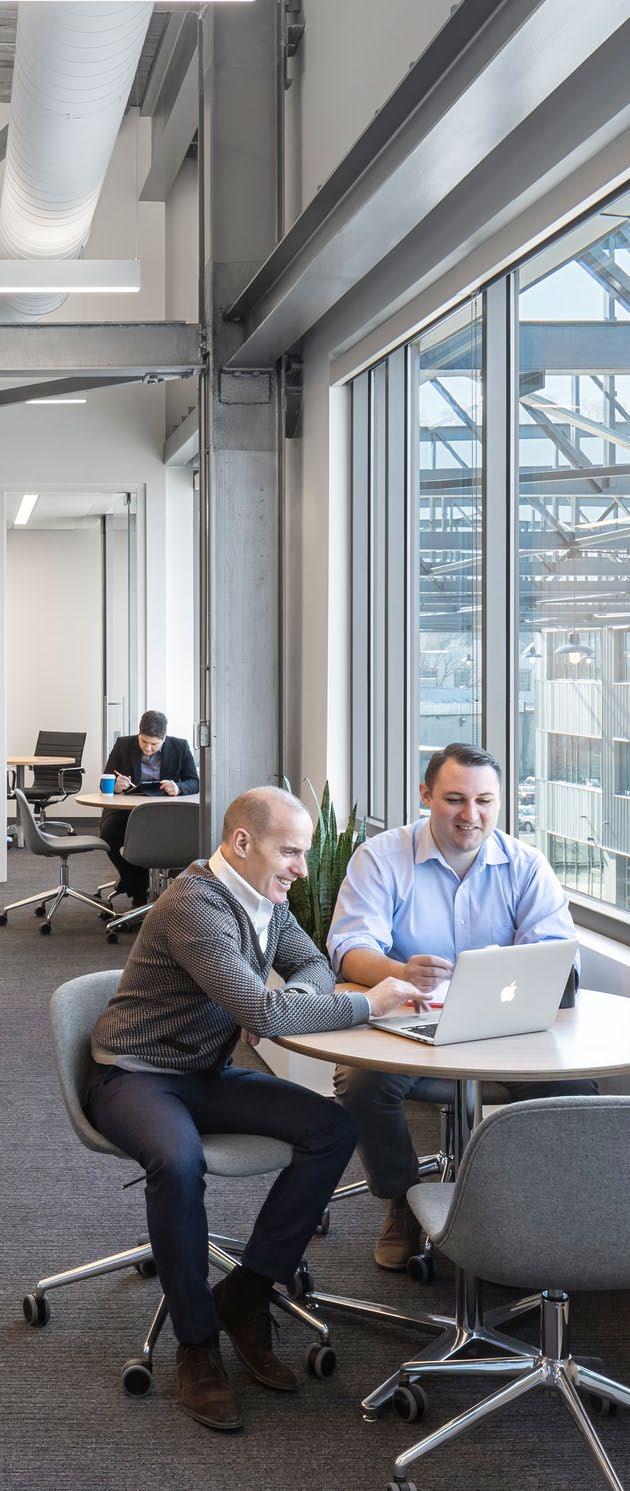
With our buildings, systems, and technologies, becoming increasingly smarter, what does the future of work and well-being look like when environment and technology experts integrate? Tech companies, scientists, and engineers, are already making strides towards incredible futures where the gap between humanity and technology is reduced, and perhaps closed. In our upcoming publication we explore technology, and its impacts on the future of work.
21 Perkins Eastman Design Research
ENDNOTES
1 Cigna. (2020, January). LONELINESS AND THE WORKPLACE: 2020 U.S. REPORT. https://www.cigna.com/static/www-cigna-com/docs/about-us/ newsroom/studies-and-reports/combatting-loneliness/cigna-2020loneliness-report.pdf
2 Express Scripts. (2020, April). America’s State of Mind Report: U.S. trends in medication use for depression, anxiety and insomnia. https://www. express-scripts.com/corporate/americas-state-of-mind-report
3 Cohn, D. (2021, February 4). As the pandemic persisted, financial pressures became a bigger factor in why Americans decided to move. PEW Research Center. https://www.pewresearch.org/fact-tank/2021/02/04/ as-the-pandemic-persisted-financial-pressures-became-a-bigger-factor-inwhy-americans-decided-to-move/
4 Popken, B. (2020, December 31). Millions of Americans moved during the pandemic — and most aren’t looking back. NBC News. https://www. nbcnews.com/business/business-news/millions-americans-moved-duringpandemic-most-aren-t-looking-back-n1252633
5 Lerner, M. (2020, October 16). Choosing the suburbs over city life during the pandemic. Washington Post. https://www.washingtonpost. com/realestate/choosing-the-suburbs-over-city-life-during-thepandemic/2020/10/15/01c94c5e-e716-11ea-97e0-94d2e46e759b_ story.html
6 Liu, J. (2021, October 14). 1 in 4 workers quit their job this year—here’s what companies are getting wrong about retention. CNBC. https://www. cnbc.com/2021/10/14/1-in-4-workers-quit-their-job-this-year-according-tonew-report.html
7 Goh, J., Pfeffer, J., & Zenios, S. A. (2015). Workplace stressors & health outcomes: health policy for the workplace. Behavioral Science & Policy Association. https://behavioralpolicy.org/wp-content/uploads/2017/02/ BSP_vol1is1_Goh.pdf
8 Pryce-Jones, J. (2010). Happiness at Work - Maximizing Your Psychological Capital for Success. Wiley-Blackwell.
9 JLL. (2020, November). Reimagining Human Experience: How to embrace the new work-life priorities and expectations of a liquid workforce. https://www.jll.co.uk/content/dam/jll-com/documents/pdf/research/jllreimagining-human-experience-11-2020.pdf
10 Rosenbaum, E. (2021, September 1). Pandemic unemployment benefits are ending, but for big companies, labor shortage worries aren’t. CNBC. https://www.cnbc.com/2021/09/01/unemployment-benefits-are-endingjob-market-hiring-worries-arent.html
11 Pfeffer, J., & Williams, L. (2020, December 8). Mental health in the workplace: The coming revolution. McKinsey & Company. https://www. mckinsey.com/industries/healthcare-systems-and-services/our-insights/ mental-health-in-the-workplace-the-coming-revolution
12 Harter, J. K., & Agrawal, S. (2012, September). Causal Relationships among Well-Being Elements and Life, Work, and Health Outcomes. Gallup.
13 Mann, B. J. H. A. A. (2017, December 12). The Right Culture: Not Just About Employee Satisfaction. Gallup. https://www.gallup.com/ workplace/236366/right-culture-not-employee-satisfaction.aspx
14 Baicker, K., Cutler, D., & Song, Z. (2010). Workplace Wellness Programs Can Generate Savings. Health Affairs, 29(2), 304–311. https://doi. org/10.1377/hlthaff.2009.0626
15 Greenberg, P. E., Fournier, A. A., Sisitsky, T., Pike, C. T., & Kessler, R. C. (2015). The Economic Burden of Adults with Major Depressive Disorder in the United States (2005 and 2010). The Journal of Clinical Psychiatry, 76(02), 155–162. https://doi.org/10.4088/jcp.14m09298
16 Workplace Wellness Lab. (2016, February 9). The 8 Dimensions of Wellness – Workplace Wellness Lab. Workplace Wellness Lab. http:// workplacewellnesslab.com/the-8-dimensions-of-wellness/
17 Pendell, B. R. (2021, March 22). Wellness vs. Wellbeing: What’s the Difference? Gallup. https://www.gallup.com/workplace/340202/ wellness-wellbeing-difference.aspx
18 Vercio, C., Loo, L. K., Green, M., Kim, D. I., & Beck Dallaghan, G. L. (2021). Shifting Focus from Burnout and Wellness toward Individual and Organizational Resilience. Teaching and Learning in Medicine, 1–9. https://doi.org/10.1080/10401334.2021.1879651
19 Mguni, N., Bacon, N., & Brown, J. F. (nd). The wellbeing and resilience paradox. The Young Foundation. https://youngfoundation.org/wp-content/ uploads/2012/10/The-Wellbeing-and-Resilience-Paradox.pdf
20 Sotile, W. M., Faloon, R. S., & Simonds, G. R. (2019). Moving From Physician Burnout to Resilience. Clinical Obstetrics & Gynecology, 62(3), 480–490. https://doi.org/10.1097/grf.0000000000000444
21 Lyubomirsky, S., Sheldon, K. M., & Schkade, D. (2005). Pursuing Happiness: The Architecture of Sustainable Change. Review of General Psychology, 9(2), 111–131. https://doi.org/10.1037/1089-2680.9.2.111
22 Recommendations synthesized from Perkins Eastman experiences and various resources including, but not limited to:
Sotile, W. M., Faloon, R. S., & Simonds, G. R. (2019). Moving From Physician Burnout to Resilience. Clinical Obstetrics & Gynecology, 62(3), 480–490. https://journals.lww.com/clinicalobgyn/Abstract/2019/09000/ Moving_From_Physician_Burnout_to_Resilience.9.aspx
Carmichael, A., Lander, F., & Steele, R. (2021, May 27). Out of the shadows: Sustainably improving workplace mental health. McKinsey & Company. https://www.mckinsey.com/featured-insights/asia-pacific/outof-the-shadows-sustainably-improving-workplace-mental-health
Petrie, K., Joyce, S., Tan, L., Henderson, M., Johnson, A., Nguyen, H., Modini, M., Groth, M., Glozier, N., & Harvey, S. B. (2018). A framework to create more mentally healthy workplaces: A viewpoint. Australian & New Zealand Journal of Psychiatry, 52(1), 15–23. https://journals.sagepub. com/doi/10.1177/0004867417726174
McKinsey & Company. (2021, July 1). National surveys reveal disconnect between employees and employers around mental health need. https:// www.mckinsey.com/industries/healthcare-systems-and-services/ourinsights/national-surveys-reveal-disconnect-between-employees-andemployers-around-mental-health-need
McKinsey & Company & 50/50 Women on Boards. (August, 2021). Prioritizing Well-being in the Workplace [Webinar].
23 Shuck, B., & Reio Jr., T. G. (2014). Employee Engagement and WellBeing: A Moderation Model and Implications for Practice. Journal of Leadership & Organizational Studies, 21(1), 43–58. https://doi. org/10.1177/1548051813494240
24 Kruse, K. (2012, June 22). What Is Employee Engagement. Forbes. https://www.forbes.com/sites/kevinkruse/2012/06/22/employeeengagement-what-and-why/?sh=16f8c8957f37
25 SHRM. (2017). Developing and Sustaining Employee Engagement. https:// www.shrm.org/resourcesandtools/tools-and-samples/toolkits/pages/ sustainingemployeeengagement.aspx
26 Witters, D. (2020, October 6). 10 Ways Leaders Can Improve Engagement and Wellbeing. Gallup. https://www.gallup.com/workplace/320108/waysleaders-improve-engagement-wellbeing.aspx
27 Schaefer, A. (2005, October 1). Commuting Takes Its Toll. Scientific American. https://www.scientificamerican.com/article/commutingtakes-its-toll/
28 Stutzer, A., & Frey, B. S. (2004). Stress that Doesn’t Pay: The Commuting Paradox. Scandinavian Journal of Economics, 110(2), 339–366. https:// doi.org/10.1111/j.1467-9442.2008.00542.x
22 Resiliency and Well-being Perkins Eastman Design Research
29 Bailey, J., R. & Cohen, A. (2021, May 20). That “Dreaded” Commute Is Actually Good for Your Health. (2021, August 27). Harvard Business Review. https://hbr.org/2021/05/that-dreaded-commute-is-actually-goodfor-your-health
30 Haapakangas, A., Hongisto, V., Varjo, J., & Lahtinen, M. (2018). Benefits of quiet workspaces in open-plan offices – Evidence from two office relocations. Journal of Environmental Psychology, 56, 63–75. https://doi. org/10.1016/j.jenvp.2018.03.003
31 O’Rourke, G. A. (2021). Workplace strategy: a new workplace model. Asia Pacific Journal of Human Resources. Published. https://doi. org/10.1111/1744-7941.12288
32 Hakky, D., van Summern, M., Glacc, C., Sinclair, C. (2021). Work from Anywhere?. Perkins Eastman. https://www.perkinseastman.com/whitepapers/work-from-anywhere/
33 Duffy, K. (2021, June 2). Nearly 40% of workers would consider quitting if their bosses made them return to the office full time, a new survey shows. Business Insider.
34 Coy, P. (2021, April 13). ‘Fear of Missing Out’ Will Drive Workers Back Into the Office. Bloomberg Business Week. https://www.bloomberg.com/ news/articles/2021-04-13/-fear-of-missing-out-will-drive-workers-backinto-the-office
35 Hawkley, L. C., & Cacioppo, J. T. (2010). Loneliness Matters: A Theoretical and Empirical Review of Consequences and Mechanisms. Annals of Behavioral Medicine, 40(2). https://doi.org/10.1007/s12160-010-9210-8
36 Cigna. (2020a). Loneliness in the Workplace. https://www.cigna.com/ static/www-cigna-com/docs/about-us/newsroom/studies-and-reports/ combatting-loneliness/cigna-2020-loneliness-factsheet.pdf
37 Hakky, D, and Chmielewski, E. (2020). Design’s Impact on Seniors’ Perceptions of Wellness. Perkins Eastman. https://www.perkinseastman. com/white-papers/designs-impact-on-seniors-perception-of-wellness/
38 Neeriemer, A., & Bell, R. (2020). Design for Safe & Healthy Children. Perkins Eastman. https://www.perkinseastman.com/white-papers/designfor-safe-healthy-children/
39 Guéguen, N. & Petr, C. (2006). Odors and consumer behavior in a restaurant. International Journal of Hospitality Management, 25, 335-339. http://dx.doi.org/10.1016/j.ijhm.2005.04.007
40 Zoladz, P. and Raudenbush, B. (2005) Cognitive Enhancement through Stimulation of the Chemical Senses. North American Journal of Psychology, 7(1), 125-140
PHOTO CREDITS
Cover: © Rawf8 / Adobe Stock
Page 2–3: Andrew Rugge / © Perkins Eastman
Page 4–5: © Connie Zhou
Page 6–7: Andrew Rugge / © Perkins Eastman
Page 8–9: Andrew Rugge / © Perkins Eastman
Page 11: Andrew Rugge / © Perkins Eastman; © Connie Zhou
Page 12–13: Andrew Rugge / © Perkins Eastman
Page 14–15: Sarah Mechling / © Perkins Eastman
Page 16: © Ofer Wolberger
Page 20–21: Andrew Rugge / © Perkins Eastman
23 Perkins Eastman Design Research
CONTACT US

Mark Van Summern
Principal Stamford
+1 203 251 7429
m.vansummern@perkinseastman.com

Connor Glass
Principal New York
+1 212 353 7311
c.glass@perkinseastman.com

Sabret Flocos
Principal Washington DC
+1 202 236 6231
s.flocos@perkinseastman.com

Heather Stonebraker
Senior Associate Raleigh
+1 984 255 0378
h.stonebraker@perkinseastman.com

Iramis Luz Audet
Associate Principal Boston
+1 617 241 5248
i.audet@perkinseastman.com

Deacon Marvel
Associate Principal Boston
+1 617 449 4048
d.marvel@perkinseastman.com
24 Resiliency and Well-being Perkins Eastman Design Research

Jeff Young
Principal Pittsburgh
+1 412 894 8308
j.young@perkinseastman.com

Barbara Mullenex
Principal Washington DC
+1 202 495 7428
b.mullenex@perkinseastman.com

Robert J. Pizzano
Principal New York
+1 212 353 7416
r.pizzano@perkinse astman.com

Heather Cain
Associate Principal Chicago
+1 312 873 6297
h.cain@perkinseastman.com

Shannon Cole
Associate Principal Stamford
+1 984 255 0378
s.cole@perkinseastman.com

Danya Hakky
Design Research Washington DC
+1 202 384 1895
d.hakky@perkinseastman.com
25 Perkins Eastman Design Research
AUTHORS
Danya Hakky , PhD, Design Research and Workplace
Sabret Flocos, IIDA, Assoc. AIA, LEED AP, Principal, Workplace Practice Leader
Connor Glass , IIDA, Principal and Board Director
Heather Cain, NCIDQ, LEED AP ID+C, Associate Principal, Workplace
Perkins Eastman is a global architecture, planning, and design firm dedicated to the idea that design can have a direct and positive impact on people’s lives. For almost forty years, our experts have shared a passion for research and design that focuses specifically on improving quality of life. We create places and spaces that put the user at the heart employing best practices, sustainability, and a thorough understanding of our clients’ missions and operations. Our diverse teams partner with our clients globally to deliver thoughtful projects suited to users who will live, work, play, learn, age, and heal within the environments we plan and design.
SPECIAL THANKS TO
Heather Jauregui, LEED AP BD+C, O+M, CPHC, Senior Associate, Perkins Eastman Director of Sustainability
Graphic design by Kim Rader.
©2021 Perkins Eastman. All rights reserved.
No part of this publication may be reproduced, stored in a retrieval system, or transmitted in any form or by any means, electronic, mechanical, photocopying, recording, scanning, or otherwise, except as permitted under Section 107 or 108 of the 1976 United States Copyright Act.
Limit of Liability/Disclaimer of Warranty: While the authors have used their best efforts in preparing this paper, they make no representations or warranties with the respect to the accuracy or completeness of the contents of this paper and specifically disclaim any implied warranties of merchantability or fitness for a particular purpose. No warranty may be created or extended by sales representatives or written sales materials. The advice and strategies contained herein may not be suitable for your situation. You should consult with a professional where appropriate. Neither the copyright holder nor the author shall be liable for damages arising herefrom.
26 Resiliency and Well-being Perkins Eastman Design Research
www.perkinseastman.com

































